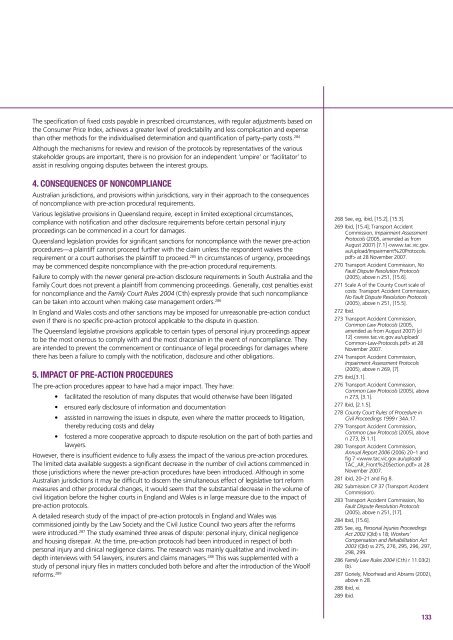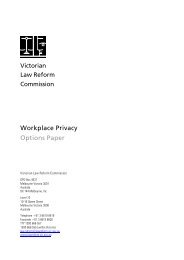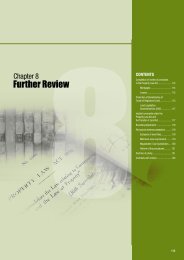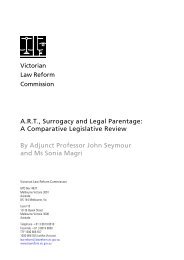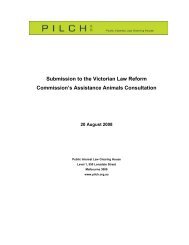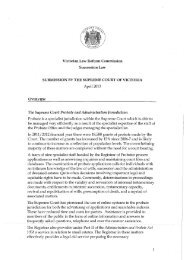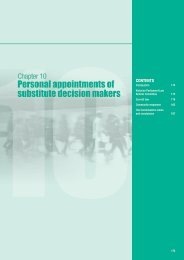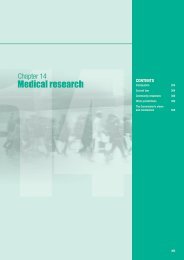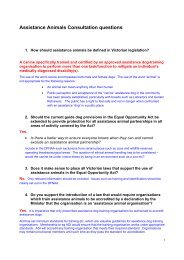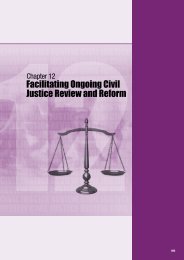Facilitating the Early Resolution of Disputes without Litigation
Facilitating the Early Resolution of Disputes without Litigation
Facilitating the Early Resolution of Disputes without Litigation
You also want an ePaper? Increase the reach of your titles
YUMPU automatically turns print PDFs into web optimized ePapers that Google loves.
The specification <strong>of</strong> fixed costs payable in prescribed circumstances, with regular adjustments based on<strong>the</strong> Consumer Price Index, achieves a greater level <strong>of</strong> predictability and less complication and expensethan o<strong>the</strong>r methods for <strong>the</strong> individualised determination and quantification <strong>of</strong> party–party costs. 284Although <strong>the</strong> mechanisms for review and revision <strong>of</strong> <strong>the</strong> protocols by representatives <strong>of</strong> <strong>the</strong> variousstakeholder groups are important, <strong>the</strong>re is no provision for an independent ‘umpire’ or ‘facilitator’ toassist in resolving ongoing disputes between <strong>the</strong> interest groups.4. CONSEQUENCES OF NONCOMPLIANCEAustralian jurisdictions, and provisions within jurisdictions, vary in <strong>the</strong>ir approach to <strong>the</strong> consequences<strong>of</strong> noncompliance with pre-action procedural requirements.Various legislative provisions in Queensland require, except in limited exceptional circumstances,compliance with notification and o<strong>the</strong>r disclosure requirements before certain personal injuryproceedings can be commenced in a court for damages.Queensland legislation provides for significant sanctions for noncompliance with <strong>the</strong> newer pre-actionprocedures—a plaintiff cannot proceed fur<strong>the</strong>r with <strong>the</strong> claim unless <strong>the</strong> respondent waives <strong>the</strong>requirement or a court authorises <strong>the</strong> plaintiff to proceed. 285 In circumstances <strong>of</strong> urgency, proceedingsmay be commenced despite noncompliance with <strong>the</strong> pre-action procedural requirements.Failure to comply with <strong>the</strong> newer general pre-action disclosure requirements in South Australia and <strong>the</strong>Family Court does not prevent a plaintiff from commencing proceedings. Generally, cost penalties existfor noncompliance and <strong>the</strong> Family Court Rules 2004 (Cth) expressly provide that such noncompliancecan be taken into account when making case management orders. 286In England and Wales costs and o<strong>the</strong>r sanctions may be imposed for unreasonable pre-action conducteven if <strong>the</strong>re is no specific pre-action protocol applicable to <strong>the</strong> dispute in question.The Queensland legislative provisions applicable to certain types <strong>of</strong> personal injury proceedings appearto be <strong>the</strong> most onerous to comply with and <strong>the</strong> most draconian in <strong>the</strong> event <strong>of</strong> noncompliance. Theyare intended to prevent <strong>the</strong> commencement or continuance <strong>of</strong> legal proceedings for damages where<strong>the</strong>re has been a failure to comply with <strong>the</strong> notification, disclosure and o<strong>the</strong>r obligations.269 Ibid, [15.4]; Transport AccidentCommission, Impairment AssessmentProtocols (2005, amended as fromAugust 2007) [7.1] at 28 November 2007.270 Transport Accident Commission, NoFault Dispute <strong>Resolution</strong> Protocols(2005), above n 251, [15.6].271 Scale A <strong>of</strong> <strong>the</strong> County Court scale <strong>of</strong>costs: Transport Accident Commission,No Fault Dispute <strong>Resolution</strong> Protocols(2005), above n 251, [15.5].272 Ibid.273 Transport Accident Commission,Common Law Protocols (2005,amended as from August 2007) [cl12] at 28November 2007.274 Transport Accident Commission,Impairment Assessment Protocols(2005), above n 269, [7].275 ibid,[3.1].276 Transport Accident Commission,Common Law Protocols (2005), aboven 273, [3.1].277 Ibid, [2.1.5].278 County Court Rules <strong>of</strong> Procedure inCivil Proceedings 1999 r 34A.17.279 Transport Accident Commission,Common Law Protocols (2005), aboven 273, [9.1.1].280 Transport Accident Commission,Annual Report 2006 (2006) 20–1 andfig 7 at 28November 2007.281 ibid, 20–21 and Fig 8.282 Submission CP 37 (Transport AccidentCommission).283 Transport Accident Commission, NoFault Dispute <strong>Resolution</strong> Protocols(2005), above n 251, [17].284 Ibid, [15.6].285 See, eg, Personal Injuries ProceedingsAct 2002 (Qld) s 18; Workers’Compensation and Rehabilitation Act2003 (Qld) ss 275, 276, 295, 296, 297,298, 299.286 Family Law Rules 2004 (Cth) r 11.03(2)(b).268 See, eg, ibid, [15.2], [15.3].5. IMPACT OF PRE-ACTION PROCEDURESThe pre-action procedures appear to have had a major impact. They have:• facilitated <strong>the</strong> resolution <strong>of</strong> many disputes that would o<strong>the</strong>rwise have been litigated• ensured early disclosure <strong>of</strong> information and documentation• assisted in narrowing <strong>the</strong> issues in dispute, even where <strong>the</strong> matter proceeds to litigation,<strong>the</strong>reby reducing costs and delay• fostered a more cooperative approach to dispute resolution on <strong>the</strong> part <strong>of</strong> both parties andlawyers.However, <strong>the</strong>re is insufficient evidence to fully assess <strong>the</strong> impact <strong>of</strong> <strong>the</strong> various pre-action procedures.The limited data available suggests a significant decrease in <strong>the</strong> number <strong>of</strong> civil actions commenced inthose jurisdictions where <strong>the</strong> newer pre-action procedures have been introduced. Although in someAustralian jurisdictions it may be difficult to discern <strong>the</strong> simultaneous effect <strong>of</strong> legislative tort reformmeasures and o<strong>the</strong>r procedural changes, it would seem that <strong>the</strong> substantial decrease in <strong>the</strong> volume <strong>of</strong>civil litigation before <strong>the</strong> higher courts in England and Wales is in large measure due to <strong>the</strong> impact <strong>of</strong>pre-action protocols.A detailed research study <strong>of</strong> <strong>the</strong> impact <strong>of</strong> pre-action protocols in England and Wales wascommissioned jointly by <strong>the</strong> Law Society and <strong>the</strong> Civil Justice Council two years after <strong>the</strong> reformswere introduced. 287 The study examined three areas <strong>of</strong> dispute: personal injury, clinical negligenceand housing disrepair. At <strong>the</strong> time, pre-action protocols had been introduced in respect <strong>of</strong> bothpersonal injury and clinical negligence claims. The research was mainly qualitative and involved indepthinterviews with 54 lawyers, insurers and claims managers. 288 This was supplemented with astudy <strong>of</strong> personal injury files in matters concluded both before and after <strong>the</strong> introduction <strong>of</strong> <strong>the</strong> Woolfreforms. 289287 Goriely, Moorhead and Abrams (2002),above n 28.288 Ibid, xi.289 Ibid.133


